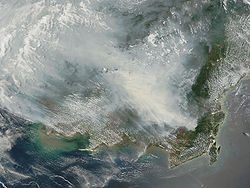.gif)
Mega Rice Project (Kalimantan)
Encyclopedia

Kalimantan
In English, the term Kalimantan refers to the Indonesian portion of the island of Borneo, while in Indonesian, the term "Kalimantan" refers to the whole island of Borneo....
, the Indonesia
Indonesia
Indonesia , officially the Republic of Indonesia , is a country in Southeast Asia and Oceania. Indonesia is an archipelago comprising approximately 13,000 islands. It has 33 provinces with over 238 million people, and is the world's fourth most populous country. Indonesia is a republic, with an...
n section of Borneo
Borneo
Borneo is the third largest island in the world and is located north of Java Island, Indonesia, at the geographic centre of Maritime Southeast Asia....
. The goal was to turn one million hectares of unproductive and sparsely populated peat swamp forest
Peat swamp forest
Peat swamp forests are tropical moist forests where waterlogged soils prevent dead leaves and wood from fully decomposing, which over time creates a thick layer of acidic peat...
into rice paddies in an effort to allieviate Indonesia's growing food shortage. The government made a large investment in constructing irrigation canals and removing trees. The project did not suceeed, and was eventually abandoned after causing considerable damage to the environment.
Overview
The peat swamp forest in the south of Kalimantan is an unusual ecology that is home to many unique or rare species such as orangutans, as well as to slow-growing but valuable trees. The peat swamp forest is a dual ecosystem, with diverse tropical trees standing on a 10m - 12m layer of peatPeat
Peat is an accumulation of partially decayed vegetation matter or histosol. Peat forms in wetland bogs, moors, muskegs, pocosins, mires, and peat swamp forests. Peat is harvested as an important source of fuel in certain parts of the world...
- partly decayed and waterlogged plant material - which in turn covers relatively infertile soil. Peat is a major store of carbon. If broken down and burned it contributes to CO2
Carbon dioxide
Carbon dioxide is a naturally occurring chemical compound composed of two oxygen atoms covalently bonded to a single carbon atom...
emissions, a source of global warming
Global warming
Global warming refers to the rising average temperature of Earth's atmosphere and oceans and its projected continuation. In the last 100 years, Earth's average surface temperature increased by about with about two thirds of the increase occurring over just the last three decades...
. Unlike northern forests, which regenerate in 10–30 years even after clear-cut felling, the peat swamp forest may take several centuries to regenerate.
The peat swamp forests of Kalimantan were being slowly cleared for small scale farming and plantations before 1997, but most of the original cover remained. In 1996 the Indonesian government initiated the Mega Rice Project (MRP), which aimed to convert one million hectares of peat swamp forest to rice paddies
Paddy field
A paddy field is a flooded parcel of arable land used for growing rice and other semiaquatic crops. Paddy fields are a typical feature of rice farming in east, south and southeast Asia. Paddies can be built into steep hillsides as terraces and adjacent to depressed or steeply sloped features such...
. Between 1996 and 1998, more than 4,000 km of drainage and irrigation channels were dug, and deforestation started in part through legal forestry and in part through burning. The water channels, and the roads and railways built for legal forestry, opened up the region to illegal forestry. In the MRP area, forest cover dropped from 64.8% in 1991 to 45.7% in 2000, and clearance has continued since then. It appears that almost all the marketable trees have now been removed from the areas covered by the MRP.
Where the forests had often flooded up to 2m deep in the rainy season, now their surface is dry at all times of the year. The government has therefore abandoned the MRP, but the drying peat is vulnerable to fires which continue to break out on a massive scale.
Peat forest destruction is causing sulphuric acid pollution of the rivers. In the rainy seasons, the canals are discharging acidic water with a high ratio of pyritic sulphate
Pyrite
The mineral pyrite, or iron pyrite, is an iron sulfide with the formula FeS2. This mineral's metallic luster and pale-to-normal, brass-yellow hue have earned it the nickname fool's gold because of its resemblance to gold...
into rivers up to 150 km upstream from the river mouth. This may be a factor contributing to lower fish catches.

